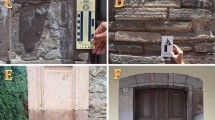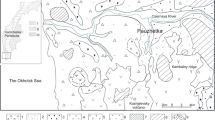Abstract
Volcanic tuffs are widely used in the Armenian architecture and represent building stones of the country’s most precious cultural heritage sites. For the very first time, extensive investigations regarding their chemical and mineralogical composition as well as the influence of petrophysical properties on their weathering behavior were realized. Different groups of tuff rocks could be identified, which differ greatly in their chroma, texture, their chemical and mineralogical composition, as well as their weathering behavior. At 30% porosity and 25% micropores, the tuff rocks show a sharp limit of changing water transport and retention behavior. Swellable clay minerals, the amount of micropores and the hygroscopic sorption value show a direct relation with the hydric expansion and proved to be reliable parameters for its estimation. Zeolite minerals proved to drastically increase the sorption values of the tuff rocks and are discussed as a cause for potential disjoining pressure. Furthermore, the application of the salt bursting test by European standard on these glass-rich volcanic tuff rocks is questioned, due to considerable different mineralogy and fabric in comparison to classic ash-rich tuffs.




































Similar content being viewed by others
References
Adamia S, Zakariadze G, Chkhotua T, Sadradze N, Tsereteli N, Chabukiani A, Gventsadze A (2011) Geology of the Caucasus. A review. Turk J Earth Sci 20(5):489–544
Allen MB, Armstrong HA (2008) Arabia–Eurasia collision and the forcing of mid-Cenozoic global cooling. Palaeogeogr Palaeoclimatol Palaeoecol 265 No(1–2):52–58
Allen MB, Kheirkhah M, Neill I, Emami MH, McLeod CL (2013) Generation of arc and within-plate chemical signatures in collision zone magmatism. Quaternary lavas from Kurdistan Province, Iran. J Petrol 54 (5):887–911
Azizi H, Moinevaziri H (2009) Review of the tectonic setting of Cretaceous to Quaternary volcanism in northwestern Iran. J Geodyn 47 No(4):167–179
Benavente D, Cueto N, Martínez-Martínez J, Del Cura MG, Cañaveras JC (2007) The influence of petrophysical properties on the salt weathering of porous building rocks. Environ Geol 52(2):215–224
Christidis GE (2013) Assessment of industrial clays. In: Developments in clay science, vol. 5, Elsevier, pp. 425–449
Correns CW, Steinborn W (1939) Experimente zur Messung und Erklärung der sogenannten Kristallisationskraft. Zeitschrift für Kristallographie-Crystalline Materials 101 (1–6):117–133
De la Calle C, Suquet H (1988) Vermiculite. Rev Miner Geochem 19 No(1):455–496
Dhilawala S (1997) Armenia, cultures of the world. Marshall Cavendish, New York (reference edn)
Dixon JB, Weed SB (1989) Minerals in soil environments. Soil Science Society of America Inc.(SSSA), Madison
Doehne E (2002) Salt weathering: a selective review. Geological Society, London, vol 205, no1, pp 51–64 (special publications)
Fisher RV (1961) Proposed classification of volcaniclastic sediments and rocks. Geol Soc Am Bull 72 (9):1409–1414
Fisher RV (1966) Rocks composed of volcanic fragments and their classification. Earth Sci Rev 1 No(4):287–298
Flatt RJ (2002) Salt damage in porous materials: how high supersaturations are generated. J Cryst Growth 242(3–4): 435–454
Gasparyan MA, Safaryan YA (2014) The problem of preservation of national traditions in modern Armenian Architecture. Adv Mater Res 1020:702–706. https://doi.org/10.4028/www.scientific.net/AMR.1020.702
Gonzalez IJ, Scherer GW (2004) Effect of swelling inhibitors on the swelling and stress relaxation of clay bearing stones. Environ Geol 46(3–4):364–377
Gregg SJ, Sing KSW, Gregg SJ, Sing KS (1982) Adsorption, surface area and porosity, 2 edn. Academic Press, London
Hirschwald J (1912) Die Prüfung der natürlichen Bausteine auf ihre Wetterbeständigkeit. W. Ernst & Sohn, Berlin
Hosono T, Uchida E, Suda C, Ueno A, Nakagawa T (2006) Salt weathering of sandstone at the Angkor monuments, Cambodia. Identification of the origins of salts using sulfur and strontium isotopes. J Archaeol Sci 33(11):1541–1551
Karapetian SG, Jrbashian RT, Mnatsakanian AK (2001) Late collision rhyolitic volcanism in the north-eastern part of the Armenian Highland. J Volcanol Geoth Res 112(1):189–220
Kaufhold S, Dohrmann R, Klinkenberg M, Siegesmund S, Ufer K (2010) N2-BET specific surface area of bentonites. J Coll Interface Sci 349(1):275–282
Keskin M (2007) Eastern Anatolia. A hotspot in a collision zone without a mantle plume. Geol soc Am 430:693 (special papers)
Klopfer H (1985) Feuchte. In: Lutz P, Jenisch R, Klopfer H et al (eds) der Bauphysik. Teubner Verlag, Stuttgart
Kocher M (2005) Quelldruckmessungen und thermische Druckmessungen an ausgewählten Sandsteinen. Dissertation, München, 2005
Koizumi M (1953) The differential thermal analysis curves and the dehydration curves of zeolites. Miner J 1 No(1):36–47
Korkuna O, Leboda R, Skubiszewska-Zie J, Vrublevs’ka T, Gun’ko VM, Ryczkowski J (2006) Structural and physicochemical properties of natural zeolites: clinoptilolite and mordenite. Microporous Mesoporous Mater 87 No(3):243–254
Le Bas MJ, Le Maitre RW, Streckeisen A, Zanettin B (1986) A chemical classification of volcanic rocks based on the total alkali–silica diagram. J Petrol 27 No(3):745–750
Le Maitre RW, Streckeisen A, Zanettin B, Le BAS, Bonin MJ, B. and Bateman P (2005) Igneous rocks: a classification and glossary of terms: recommendations of the International Union of Geological Sciences Subcommission on the Systematics of Igneous Rocks. Cambridge University Press, Cambridge
López-Arce P, Fort R, Gómez-Heras M, Pérez-Monserrat E, Varas-Muriel MJ (2011) Preservation strategies for avoidance of salt crystallisation in El Paular Monastery cloister, Madrid, Spain. Environ Earth Sci 63(7–8):1487–1509
López-Doncel R, Wedekind W, Leiser T, Molina-Maldonado S, Velasco-Sánchez A, Dohrmann R, Kral A, Wittenborn A, Aguillón-Robles A, Siegesmund S (2016) Salt bursting tests on volcanic tuff rocks from Mexico. Environ Earth Sci 75(3):212
Lubelli B, van Hees RPJ, Nijland TG (2014) Salt crystallization damage: how realistic are existing ageing tests? In: De Clercq H (ed) SWBSS 2014 3th International Conference on Salt Weathering of Buildings and Stone Sculptures, Brussels, 14–16 October 2014, Royal Institute for Cultural Heritage (KIK/IRPA), pp 259–274
Lubelli B, Cnudde V, Diaz-Goncalves T, Franzoni E, van Hees RPJ, Ioannou I, Menendez B, Nunes C, Siedel H, Stefanidou M (2018) Towards a more effective and reliable salt crystallization test for porous building materials. State of the art. Mater Struct 51 No(2):55
Meier L, Kahr G (1999) Determination of the cation exchange capacity (CEC) of clay minerals using the complexes of copper (II) ion with triethylenetetramine and tetraethylenepentamine. Clays Clay Miner 47:386–388
Meliksetian K, Savov I, Connor C, Halama R, Jrbashyan R, Navasardyan G, Ghukasyan Y, Gevorgyan H, Manucharyan D, Ishizuka O (2014) Aragats stratovolcano in Armenia-volcano-stratigraphy and petrology. In: Geophysical Research Abstracts, vol 16, EGU2014-567-2
Neill I, Meliksetian K, Allen MB, Navarsardyan G, Karapetyan S (2013) Pliocene–Quaternary volcanic rocks of NW Armenia. Magmatism and lithospheric dynamics within an active orogenic plateau. In: Lithos, vol 180, pp 200–215. https://doi.org/10.1016/j.lithos.2013.05.005
Padilla-Ceniceros R, Pacheco-Martínez J, López-Doncel RA, Orenday-Tapia EE (2017) Rock deterioration in the masonry walls of the Cathedral Basilica of Aguascalientes, Mexico. Revista Mexicana de Ciencias Geológicas 34(2):138–139
Pötzl C, Dohrmann R, Siegesmund S (2018) Clay swelling mechanism in tuff stones: an example of the Hilbersdorf Tuff from Chemnitz, Germany. Environ Earth Sci 77(5):188
Reichenbach HG, Beyer J (1995) Dehydration and rehydration of vermiculites. II: Phlogopitic CA-vermiculite. Clay Miner 30(4):273–286
Rodriguez-Navarro C, Doehne E (1999) Time-lapse video and ESEM: integrated tools for understanding processes in situ. Am Lab 31 (10):28–35
Rolland Y (2017) Caucasus collisional history. Review of data from East Anatolia to West Iran. Gondwana Res 49:130–146
Rolland Y, Billo S, Corsini M, Sosson M, Galoyan G (2009) Blueschists of the Amassia-Stepanavan suture zone (Armenia). Linking Tethys subduction history from E-Turkey to W-Iran. Int J Earth Sci 98 No(3):533–550
Ruedrich J, Siegesmund S (2007) Salt and ice crystallisation in porous sandstones. Environ Geol 52(2):225–249
Ruedrich J, Bartelsen T, Dohrmann R, Siegesmund S (2011) Moisture expansion as a deterioration factor for sandstone used in buildings. Environ Earth Sci 63(7–8):1545–1564
Scherer GW (1999) Crystallization in pores. Cem Concr Res 29(8):1347–1358
Schuh H (1987) Physikalische Eigenschaften von Sandsteinen und ihren verwitterten Oberflächen, Münchner geowissenschaftliche Abhandlungen. Reihe B, Allgemeine und angewandte Geologie, vol 6. F. Pfeil, München
Sheth H, Meliksetian K, Gevorgyan H, Israyelyan A, Navasardyan G (2015) Intracanyon basalt lavas of the Debed River (northern Armenia), part of a Pliocene–Pleistocene continental flood basalt province in the South Caucasus. J Volcanol Geoth Res 295:1–15
Shirinyan CG (1962) Volcanic tuffs and tuff lavas of Armenia. Bulletin Volcanologique 24(1):171–175
Siedel H (2010) Historic building stones and flooding: changes of physical properties due to water saturation. J Perform Constr Facil 24(5):452–461
Siegesmund S, Dürrast H (2011) Physical and mechanical properties of rocks. In: Siegesmund S, Snethlage R (eds) Stone in architecture. Springer, Berlin, Heidelberg, pp 97–225
Siegesmund S, Sousa L, Knell C (2018) Thermal expansion of granitoids. Environ Earth Sci 77(2):41
Snethlage R (1984) Steinkonservierung. Arbeitsheft Bayer. Landesamt f. Denkmalpflege, 22
Snethlage R, Wendler E, Klemm DD (1995) Tenside im Gesteinsschutz-bisherige Resultate mit einem neuen Konzept zur Erhaltung von Denkmälern aus Naturstein”, Denkmalpflege und Naturwissenschaft-Natursteinkonservierung I. Verlag Ernst & Sohn, Berlin, pp 127–146
Sousa L, Siegesmund S, Wedekind W (2018) Salt weathering in granitoids. An overview on the controlling factors. Environ Earth Sci 77(13):502
Steiger M, Charola AE, Sterflinger K (2011) Weathering and deterioration. In: Siegesmund S, Snethlage R (eds) Stone in architecture, Springer, pp 227–316
Steindlberger E (2004) Volcanic tuffs from Hesse (Germany) and their weathering behaviour. Environ Geol 46(3–4):378–390
Stück H, Forgó LZ, Rüdrich J, Siegesmund S, Török A (2008) The behaviour of consolidated volcanic tuffs: weathering mechanisms under simulated laboratory conditions. Environ Geol 56(3–4):699–713
Stück H, Siegesmund S, Rüdrich J (2011) Weathering behaviour and construction suitability of dimension stones from the Drei Gleichen area (Thuringia, Germany). Environ Earth Sci 63(7–8):1763–1786
Ufer K, Kleeberg R, Bergmann J, Dohrmann R (2012a) Rietveld refinement of disordered illite-smectite mixed-layer structures by a recursive algorithm. I: One-dimensional patterns. Clays Clay Miner 60(5):507–534
Ufer K, Kleeberg R, Bergmann J, Dohrmann R (2012b) Rietveld refinement of disordered illite-smectite mixed-layer structures by a recursive algorithm. II: Powder-pattern refinement and quantitative phase analysis. Clays Clay Miner 60(5):535–552
Utudjian E (1968) Armenian Architecture: 4th to 17th Century, Editions A. Morance
Wangler T, Scherer GW (2008) Clay swelling mechanism in clay-bearing sandstones. Environ Geol 56(3–4):529–534. https://doi.org/10.1007/s00254-008-1380-3
Wedekind W, López-Doncel R, Dohrmann R, Kocher M, Siegesmund S (2013) Weathering of volcanic tuff rocks caused by moisture expansion. Environ Earth Sci 69(4):1203–1224
Weimann MB (2001) Hygrische Eigenschaften von Polymerbeton im Vergleich mit porösen mineralischen Werkstoffen des Bauwesens. Dissertation, ETH Zurich, 2001
Weiss T, Siegesmund S, Kirchner Dt, Sippel J (2004) Insolation weathering and hygric dilatation: two competitive factors in stone degradation. Environ Geol 46(3–4):402–413
Wellman HW, Wilson AT (1965) Salt weathering, a neglected geological erosive agent in coastal and arid environments. Nature 205 (4976):1097
Acknowledgements
We are grateful to M. Sitnikova, K. Ufer and N. Schleuning for their help with the mineral analyses, as well as L. Sousa for the constructive scientific discussion and excellent suggestions. We thank M. and V. Safaryan, Z. Madoyan, R. López-Doncel, M. Teipel, F. Malis and K. Nedkov for the help with the sampling and sample transfer to Germany. Constructive review by two anonymous reviewers is gratefully acknowledged. This work was supported by the Volkswagen Foundation (AZ93919) and the Deutsche Bundesstiftung Umwelt (AZ20017/481).
Author information
Authors and Affiliations
Corresponding author
Additional information
This article is part of a Topical Collection in Environmental Earth Sciences on “Stone in the Architectural Heritage: from quarry to monuments—environment, exploitation, properties and durability”, guest edited by Siegfried Siegesmund, Luís Sousa, and Rubén Alfonso López-Doncel.
Rights and permissions
About this article
Cite this article
Pötzl, C., Siegesmund, S., Dohrmann, R. et al. Deterioration of volcanic tuff rocks from Armenia: constraints on salt crystallization and hydric expansion. Environ Earth Sci 77, 660 (2018). https://doi.org/10.1007/s12665-018-7777-8
Received:
Accepted:
Published:
DOI: https://doi.org/10.1007/s12665-018-7777-8




